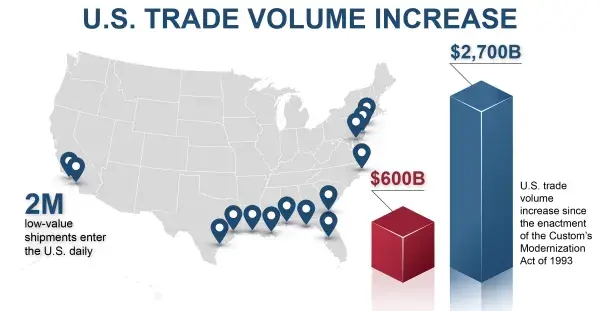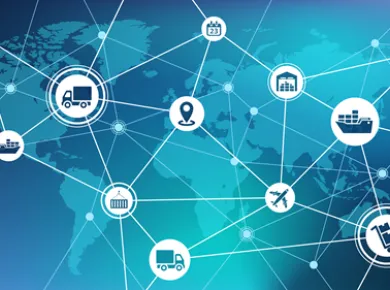U.S. Customs and Border Protection (CBP) Business Transformation and Innovation Division (BTID) actively engages in providing strategic insight for the Office of Trade (OT). Testing in advance of a procurement or acquisition allows CBP to intelligently invest in future technologies that facilitate, secure, and reduce costs related to the movement of cargo. As an innovation group, the team utilizes fail-fast techniques, which reduce expenditures on technologies that may initially appear appealing but ultimately have insufficient business value. BTID focuses on assessing and analyzing new technologies within the parameters of CBP’s business needs and provides a futuristic vision of products and software, enabling the agency to proactively pursue advancements in the technical environment.
Since the enactment of the Customs Modernization Act of 1993, U.S. trade volumes have increased from $600 billion to over $2,700 billion per year, with nearly two million low-value shipments entering the country daily.
Concurrently, supply chains have become increasingly dynamic and complex. To meet current trade challenges, transformational change is needed to protect American workers and businesses, ensure fair competition, increase transparency and accountability in the supply chain, and enable the swift and secure movement of legitimate goods across the U.S. border.
In 2018, CBP entered a joint venture with Department of Homeland Security Science and Technology Directorate to explore the principles of blockchain. In 2019, the focus shifted toward broader ledger concepts, including Distributed Ledger Technology (DLT). In 2021, CBP pivoted to interoperability standards.
CBP is committed to developing and adopting standards for global interoperability among legacy, current, and emerging technologies, including DLTs. Interoperability will allow CBP to receive and transmit data with traditional and non-traditional trade partners in near real-time. For trade, interoperability will provide flexibility to choose the most efficient way to exchange data with CBP. Broad implementation of these standards also aims to future-proof CBP and the private sector, enabling systems to be adapted an enhanced as new technologies emerge.
CBP, in collaboration with DHS S&T, under the program heading of the Silicon Valley Innovation Program (SVIP), has embarked on five projects testing global interoperability standards in the steel, natural gas, pipeline oil, food safety, and e-commerce sectors. These projects will lay the foundation for ACE 2.0, CBP’s current effort to modernize the Automated Commercial Environment (ACE). With these advancements, ACE will remain at the forefront of international data exchange and facilitate CBP’s ability to better identify high-risk imports, increase supply chain transparency, verify compliance, and ensure appropriate revenue collection.
To learn more about each topic, select the buttons below:
Key Terms
Distributed Ledger Technology (DLT): a type of database that stores data across a network of computers rather than on a single server. DLT ensures there is no single person or group with control – instead, all users collectively retain control.
Blockchain: a type of DLT that stores data in “blocks” linked together in a “chain.” For each new transaction, information is verified and encrypted into a “block” that is added to the end of the chain, creating a permanent, immutable history of all transactions.
Interoperability: the ability of different computer systems and software to communicate with each other.
Interoperability standards: detailed descriptions, or blueprints, that guide software development and enable different systems to connect and exchange data.
ACE 2.0: CBP’s current modernization effort for the Automated Commercial Environment (ACE) system.
Additional Information
So far, CBP’s investment into interoperability has demonstrated exciting results, including the ability to expedite cargo processing, support enhanced enforcement activity, and future-proof the trade process through choice of technology.
For an overview of the relationship between global interoperability testing and ACE 2.0, click here: Trade Innovation: Global Interoperability Testing and ACE 2.0.
CBP Business Connection
CBP’s Business Connection (BC) is an online platform that allows companies to pitch their products and services to various CBP offices. CBP-BC provides a streamlined way for technology corporations that do business in the U.S. to share their newest technology that aligns with CBP’s mission of protecting the American people, safeguarding the U.S. borders, and enhancing the nation’s economic prosperity. Learn more at the CBP Business Connection web page.
Feedback
If you would like to provide feedback on current projects, please email: OTinnovation@cbp.dhs.gov.





